Scottish Study of Early Learning and Childcare: Phase 1 Report - Updated 2021
Phase 1 of the Scottish Study of Early Learning and Childcare (SSELC) aimed to gather a robust baseline of child and parent outcomes for a cohort of eligible two-year-olds who were receiving 600 hours of funded early learning and childcare provision.
Parent outcomes
Economic activity
Parents were asked which, from a range of activities – including working 30 hours or more or being in full-time education – they had done in the last week. As shown in Table 7, looking after the home or family was the activity most likely to have been reported by parents with 70% saying they had done so in the previous seven days.
Table 7: Parent’s economic activity*
| What were you doing last week, that is the seven days ending last Sunday? |
All |
|---|---|
| Working 30 or more hours a week (including if currently on leave or sick) |
10 |
| Working fewer than 30 hours a week (including if currently on leave or sick) |
21 |
| On maternity/parental leave from an employer |
2 |
| Looking after home or family |
70 |
| Waiting to take up paid work already obtained |
0 |
| Out of work and looking for a job |
9 |
| Out of work, because of long-term sickness or disability |
9 |
| On a Government training or employment scheme |
0 |
| In full-time education (including on vacation) |
5 |
| In part-time education (including on vacation) |
1 |
| Wholly retired |
1 |
| Not in paid work for some other reason |
11 |
| Unweighted base |
422 |
Base: All respondents (parent survey)
*Note: respondents were able to choose more than one response. As such, percentages will not total 100%.
A total of 33% of respondents reported that they were in work, with 10% reporting working full-time (30 or more hours a week), 21% working part-time, and 2% being on maternity or parental leave from an employer. A further 9% reported that they were out of work and looking for a job.
Economic activity varied a little according to area deprivation (see Table B12 in Appendix B). For example, parents living in the most deprived 20% of areas, although only being slightly less likely to say they were in work than parents living in other areas (31% compared with 35% including those on maternity/parental leave), they were far less likely to be working full-time (5% compared with 16%) and more likely to be working part-time (24% compared with 18%).
Alongside information about current economic activity, the parent questionnaire also asked respondents a series of attitudinal questions related to use of childcare and the impact this has on employment opportunities.
Those who were employed or in training were asked whether they agreed or disagreed with the following statement: “If I could afford good quality childcare which was reliable, convenient and affordable, I would work more hours.” Figure 25 shows the total responses to this question and a breakdown of responses by area deprivation.
Just over a third of respondents (36%) agreed with this statement, while a similar proportion (34%) disagreed. Those living in the most deprived 20% of areas were more likely than those in less deprived areas (Figure 25) to strongly agree that they would work more hours if they could afford childcare (27% compared with 12%).
Figure 25: Whether would work more hours if could afford childcare by area deprivation
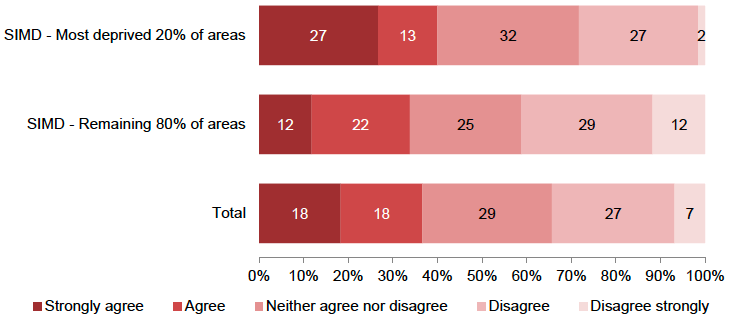
Base: All respondents currently in paid employment or training (parent survey)
Single parents and couple parents were equally likely to agree with this statement (36% and 35% agreeing or strongly agreeing respectively). However, single parents were more likely than couple parents to strongly agree (21% compared with 15%). The bases are too small to explore differences by parental education level.
Parents who were not working were asked whether they agreed or disagreed with the following statement: “A lack of affordable, convenient, good quality childcare is one of the main reasons I’m not working at the moment.” Thirty-two percent of parents agreed with this statement whilst 43% disagreed. As shown in Figure 26, a higher proportion of single parents than those in two parent households agreed that this was the case.
Figure 26: Whether a main reason not working is because of a lack of childcare by number of parents in household
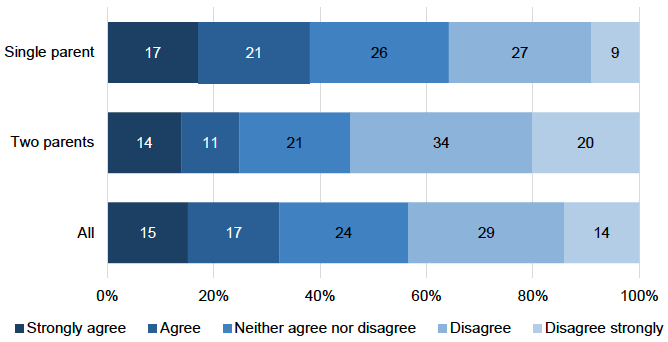
Base: All respondents currently not in paid employment or training (parent survey)
Parents living in the most deprived 20% of areas were less likely to agree/strongly agree with this statement than those living in other areas (27% compared with 37%). More similar proportions disagreed/strongly disagreed (46% compared with 43%) with parents in more deprived areas more likely to neither agree or disagree than parents in other areas (27% compared with 20%). Amongst parents with different qualification levels, those with no qualifications were least likely to agree/strongly agree (20%) whilst those with Higher/Advanced Higher grades or equivalent were most likely to agree/strongly agree (49%). Twenty-eight percent of degree-educated parents agreed.
In an attempt to examine attitudes which may affect the number of parents in work, the survey asked parents whether they agreed or disagreed with this statement: “A two-year-old child is likely to suffer if his or her mother works.” One in ten respondents (10%) agreed that a child would suffer if the mother worked, while 63% disagreed. There were no notable differences in levels of agreement between parents in single and two parent households and between those living in the 20% most deprived areas and less deprived areas.
Parental health and wellbeing
Most respondents (63%) rated their own general health as being good or very good, with 28% rating it as fair and 9% considering it to be bad or very bad. Self-reported good health appears to be lower among mothers responding to the parent survey than generally amongst mothers in Scotland with children under school age. For example, the Scottish Health Survey 2017 found 83% of mothers of children aged under 5 reported their health to be good or very good with only 3% saying it was bad or very bad[26].
Parents living in the most deprived 20% of areas were less likely than those living in other areas to rate their health as good or very good (59% compared with 65%). There was no clear trend in general health by parent level of education and no notable differences between single parents and those in couple households (see Tables B13 and B14 in Appendix B).
Two-fifths (41%) of all respondents had at least one longstanding illness. This represents poorer health than amongst a nationally comparable group of mothers from the Scottish Health Survey, of whom 27% reported having a longstanding illness. A little over one-third (36%) of all respondents had a limiting longstanding illness. Amongst those with a longstanding illness, 28% reported that their illness limited their activities ‘a lot’ whilst a further 59% said they were limited ‘a little’.
Figure 27: Respondent/parent longstanding illness by sex, single parent/couple household and area deprivation
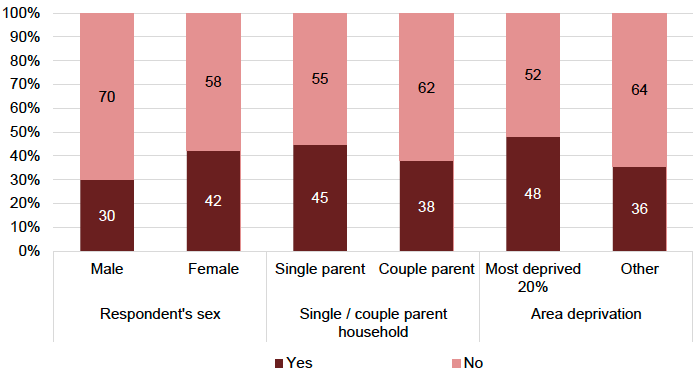
Base: All respondents (parent survey)
As shown in Figure 27, longstanding illness was more common amongst parents who were female (42% compared with 30% amongst males), living in a single parent household (45% compared with 38% for parents in couple households) and those living in the most deprived 20% of areas (48% compared with 36% amongst those living in other areas). There was no linear trend according to level of education. Parents with a highest qualification at Higher Grade or equivalent were most likely to report a longstanding illness (56%) whilst those with an HNC/HND level qualification were least likely to report one (33%).
Parents with a longstanding illness were asked whether and how it affected them. Responses are summarized in Table 8. As can be seen, more than three-quarters (79%) of those who had a longstanding illness reported that their mental health was affected.
Table 8: How longstanding condition or illness affects parent
| All |
|
|---|---|
| Vision |
4 |
| Hearing (e.g. due to deafness or partial hearing) |
5 |
| Mobility, such as difficulty moving around |
23 |
| Learning or concentrating or remembering |
22 |
| Stamina or breathing difficulty |
14 |
| Mental health, social emotional or behavioural issues |
79 |
| Other impairment(s) |
12 |
| Unweighted base |
171 |
Base: All children with a long-term condition (parent survey)
Respondents were asked to rank their life satisfaction on a scale from zero to 10, with zero being extremely dissatisfied and 10 being extremely satisfied. The average score for all respondents was 7.2, a little below that of the national sample from the Scottish Health Survey, where the mean response for mothers of children aged under five was 8.1.
There was little notable variation in mean life satisfaction score by respondent characteristics. However, looking at the proportions with scores within different ranges (Figure 28) illustrates some differences that the mean scores do not identify. For example, 31% of couple parents score 9 or 10 on the scale compared with 21% of single parents. Amongst parents with different levels of qualifications, those with higher qualifications were more likely to score 9 or 10 on the scale.
Figure 28: Life satisfaction score by single parent/couple household and parent’s highest level of education
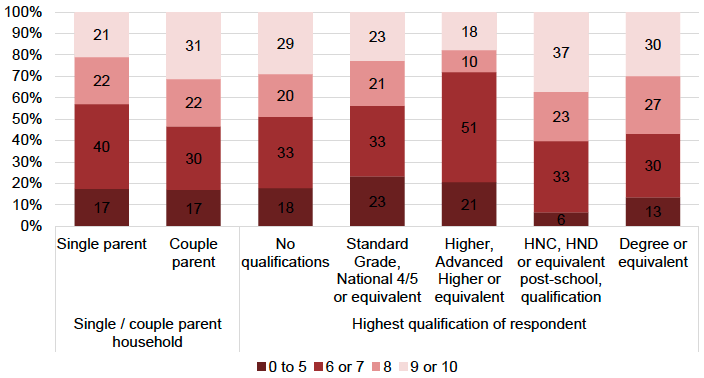
Base: All respondents (parent survey)
The Short Warwick-Edinburgh Mental Wellbeing Scale (SWEMWBS) was also included in the parent survey. This is comprised of seven questions asking how the respondent had been feeling over the previous two weeks. Responses to these questions were used to create a scale, with scores ranging from 7 to 35. The mean score of 23.2 was very similar to that from the nationally representative sample of mothers with a child aged under 5 in the Scottish Health Survey (mean of 22.9)[27] and indeed to the national average for all adults and that for all women (each being 22.9 and 22.8).
As shown in Table 9, there are some small differences in mean wellbeing scores by area deprivation and parental level of education. Parents living in the most deprived 20% of areas had slightly lower scores (22.9) than those living in other areas (23.4). Those with no or lower levels of qualifications also tended to have lower scores than those with higher qualifications. For example, the mean score amongst parents with lower school level qualifications was 22.8 compared with 23.8 amongst parents with a degree level qualification. Differences between single and couple parents were smaller (23.2 compared with 23.4).
Table 9: Mean SWEMWBS score by area deprivation and parent’s highest level of education
| Mean score |
|
|---|---|
| Area deprivation |
|
| Most deprived 20% |
22.9 |
| Other areas |
23.4 |
| Parent’s highest level of education |
|
| No qualifications |
22.7 |
| Standard Grade, National 4/5 or equivalent |
22.8 |
| Higher, Advanced Higher or equivalent |
22.2 |
| HNC, HND or equivalent post-school, qualification |
24.5 |
| Degree or equivalent |
23.8 |
| Unweighted base |
419 |
Base: All respondents (parent survey)
Respondents were also asked how they were coping as a parent/carer (Figure 29). More than half felt they were coping well most or all of the time (56%). A further 41% felt they were coping sometimes, and only 3% reported that they were not coping very well. There were no notable differences in response by single/couple parent households nor by area deprivation.
Figure 29: Extent to which respondent feels they are coping as a parent/carer
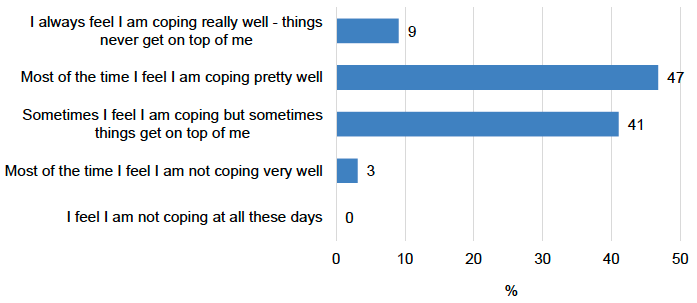
Base: All respondents (parent survey)
A key interest of the study is the impact of children attending ELC on how parents use their time and on their wellbeing. Parents were asked to indicate whether they agreed or disagreed that they had participated in certain activities or experienced a change in feelings specifically because their child was in nursery. The responses are summarised in Figure 30.
As the graph shows, parents perceived an overall positive effect of having their child in ELC. Most agreed they felt happier (54%), less stressed (61%), that they had more time to themselves (69%) and that they had been able to think about what they may do in the future (68%). Only a small proportion of parents agreed that having their child in nursery had allowed them to increase their working hours (11%) but a significant minority agreed it had allowed them to look for work (41%) or undertake study or training (27%).
Figure 30: Activities done/perceived change in feelings because of child being in nursery
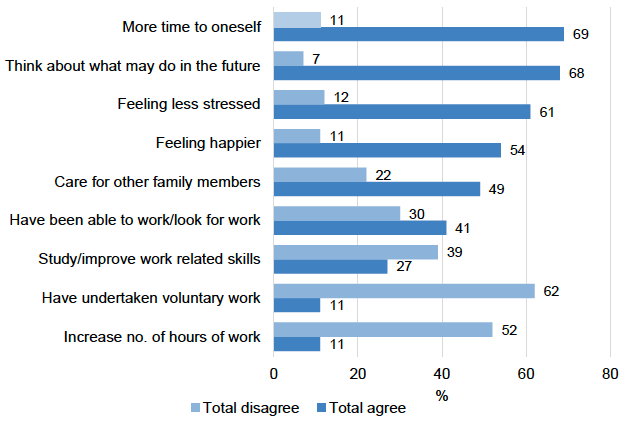
Base: All respondents (parent survey)
Differences in agreement with selected activities and perceived change – being able to think about the future; feeling less stressed; been able to work/look for work; been able to study/improve work related skills – were compared according to parent characteristics. The results are summarised in Table 10.
Single parents were more likely than parents in couple households to agree that having their child in nursery had allowed them to think about the future (72% compared with 62%). They were also more likely to say they had been able to look for work (44% compared with 38%). There were no notable differences by area deprivation (see Table B15 in Appendix B).
In relation to SDQ total difficulties scores, parents whose children had a close to average score were generally more likely than those whose child had a higher score to agree that their feelings had changed and that they had engaged in activities as a result of their child being in nursery. For example, 49% of parents whose child had a close to average score reported being able to look for work compared with 37% of those whose children had a very high score.
Table 10: % agreeing activities done/perceived change in feelings because of child being in nursery by single/couple household and child’s SDQ total difficulties score
| Think what may do in future |
Feeling less stressed |
Able to look for work |
Study/ train |
Base: All respondents (parent survey) |
||||||||||
|---|---|---|---|---|---|---|---|---|---|---|---|---|---|---|
| Single/couple parent household |
||||||||||||||
| Single parent |
72 |
62 |
44 |
27 |
208 |
|||||||||
| Couple household |
62 |
59 |
38 |
27 |
174 |
|||||||||
| SDQ total difficulties score |
||||||||||||||
| Close to average |
74 |
65 |
49 |
32 |
162 |
|||||||||
| Slightly raised |
59 |
55 |
35 |
22 |
95 |
|||||||||
| High |
67 |
62 |
34 |
26 |
58 |
|||||||||
| Very high |
67 |
56 |
37 |
24 |
59 |
|||||||||
Contact
Email: socialresearch@gov.scot
There is a problem
Thanks for your feedback